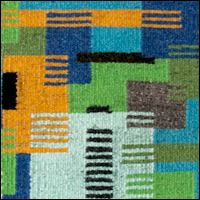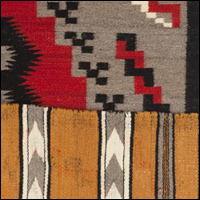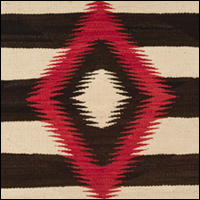

Click on the thumbnail images below to view larger images of the weavings. Links in text show details of the designs.

In the 1960s Glenmae Tsosie from St. Michaels, Arizona, worked as a craft demonstrator at the Navajo Tribal Museum in Window Rock, Arizona. She was presented with shiny synthetic yarns by the Director at the time, Martin Link and asked to weave a rug in the most nontraditional design she could imagine. The result was a vibrant modern creation that resembles a Mondrian painting. Glenmae made a total of three rugs combining geometric blocks and lines, one of which was purchased in 1972 for the museum collection.

This "Ganado type" rug is woven in a two-faced weave. This weave structure is related to twill weave and produced a textile with different patterns on each surface and required at least four heddles to create. It was quite uncommon on the Navajo Reservation and few weavers attempt this complex weave on a traditional Navajo vertical loom. The structure has not been identified in prehistoric or historic Pueblo textiles and traders did not recognize two-faced rugs until the 1890s. This technique was known to non-Native weavers and may have been learned from them or a Navajo weaver may have discovered it while experimenting with twill weave structures.

Chief blankets may be most well known Navajo textiles produced during the Classic (1650-1865) and Early Transition (1865-95) periods, usually of outstanding quality in both weaving technique and materials. These textiles were widely traded between the Navajo and other Native peoples in the Southwest and the Great Plains and could be worn by anyone. The blankets changed stylistically over time and are usually categorized into several phases. Although we often think of these phases as having very standardized designs, in reality Navajo weavers produced numerous variations.
This rug is possibly a Hubbell reproduction. A regional style developed around Juan Lorenzo Hubbell's trading post at Ganado, Arizona in the early 1900s. He favored designs from the Classic period and many "Hubbell revival" textiles imitate classic designs in red with natural black, white, or grey yarns, such as this blanket from the museum collection.

This blanket exhibits elements associated with Phase III chief blankets with terraced triangular blocks in nine or twelve-spot arrangements. Variations of this pattern were produced well into the 20th century. Chief blankets were designed to be worn. When wrapped around the body the design elements were no longer static but moved gracefully with the wearer. The front of the garment shows the completed diamonds only when draped around the body, creating an impressive kinetic work of art.